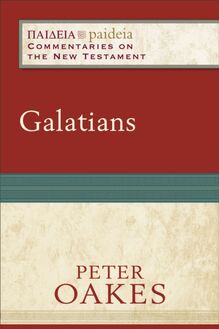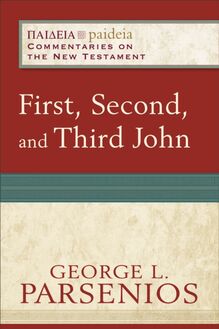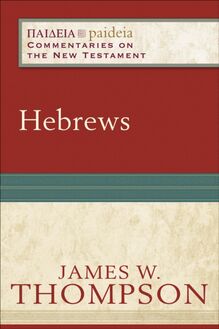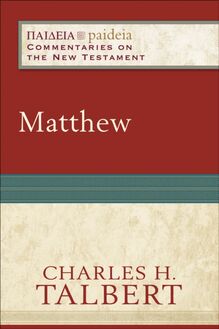-
 Univers
Univers
-
 Ebooks
Ebooks
-
 Livres audio
Livres audio
-
 Presse
Presse
-
 Podcasts
Podcasts
-
 BD
BD
-
 Documents
Documents
-
- Cours
- Révisions
- Ressources pédagogiques
- Sciences de l’éducation
- Manuels scolaires
- Langues
- Travaux de classe
- Annales de BEP
- Etudes supérieures
- Maternelle et primaire
- Fiches de lecture
- Orientation scolaire
- Méthodologie
- Corrigés de devoir
- Annales d’examens et concours
- Annales du bac
- Annales du brevet
- Rapports de stage
La lecture à portée de main
Vous pourrez modifier la taille du texte de cet ouvrage
Découvre YouScribe en t'inscrivant gratuitement
Je m'inscrisFirst Corinthians (Paideia: Commentaries on the New Testament) , livre ebook
Découvre YouScribe en t'inscrivant gratuitement
Je m'inscrisEn savoir plus
Vous pourrez modifier la taille du texte de cet ouvrage
En savoir plus

Description
Informations
| Publié par | Baker Publishing Group |
| Date de parution | 01 avril 2012 |
| Nombre de lectures | 0 |
| EAN13 | 9781441240293 |
| Langue | English |
| Poids de l'ouvrage | 3 Mo |
Informations légales : prix de location à la page 0,0864€. Cette information est donnée uniquement à titre indicatif conformément à la législation en vigueur.
Extrait
G ENERAL E DITORS
Mikeal C. Parsons and Charles H. Talbert
A DVISORY B OARD
Paul J. Achtemeier
Loveday Alexander
C. Clifton Black
Susan R. Garrett
Francis J. Moloney
© 2012 by Pheme Perkins
Published by Baker Academic a division of Baker Publishing Group PO Box 6287, Grand Rapids, MI 49516-6287 www.bakeracademic.com
Ebook edition created 2012
All rights reserved. No part of this publication may be reproduced, stored in a retrieval system, or transmitted in any form or by any means for example, electronic, photocopy, recording without the prior written permission of the publisher. The only exception is brief quotations in printed reviews.
eISBN 978-1-4412-4029-3
Library of Congress Cataloging-in-Publication Data is on file at the Library of Congress, Washington, DC.
Unless otherwise noted, all quotations from 1 Corinthians are the author’s own translation. All other Scripture quotations are from the New Revised Standard Version of the Bible, copyright ©1989, by the Division of Christian Education of the National Council of the Churches of Christ in the United States of America. Used by permission. All rights reserved.
Contents
Cover
Title Page
Copyright Page
List of Figures and Tables
Foreword
Preface
Abbreviations
Introduction
1 Corinthians 1:1–9 (The Letter Opening)
1 Corinthians 1:10–2:16 (Against Divisions: God’s Wisdom)
1 Corinthians 3:1–4:21 (Against Divisions: Paul and Apollos as Exempla )
1 Corinthians 5:1–6:20 (Reports about Unholy Conduct among Believers)
1 Corinthians 7:1–11:1 (Questions in a Letter from Corinth)
1 Corinthians 11:2–14:40 (Problems in the Community Assembled for Worship)
1 Corinthians 15:1–58 (Reports That Some Deny the Resurrection)
1 Corinthians 16:1–24 (The Letter Closing)
Bibliography
Index of Subjects
Index of Modern Authors
Index of Scripture and Ancient Sources
Back Cover
Figures and Tables
Figures
1. The Diolkos at Corinth
2. Erastus Inscription
3. Fountain of Peirene
4. The Acrocorinth
5. The Egyptian God Sarapis
6. The Rites of Isis
7. Animals for Sacrifice
8. Gallio Inscription
9. Map of Paul’s Journey East from Corinth
10. Theater Ruins
11. Persons Assembled at an Altar for a Sacrifice
12. Roman Woman’s Hairstyle
13. Woman with Head Covering
14. Map of the Mediterranean Region
Tables
1. Paul’s Rhetoric against Divisions at Corinth
2. Scripture Citations in 1 Corinthians
3. Thanksgiving Anticipates the Content of 1 Corinthians
4. Greeting Formulas in 1–2 Corinthians and Philippians
5. The Objects and Purposes of God’s Call
6. Paul’s Style of Preaching in Corinth
7. Mystery as God’s Plan of Salvation
8. Scripture Citations Related to 1 Corinthians 2:9
9. The Corinthians and the Apostles Compared
10. Vice Lists in 1 Corinthians 5–6
11. Exodus Motifs in 1 Corinthians 10:1–5
12. Versions of Jesus’s Words over the Bread and Cup
13. Spiritual Gifts of Speech and Knowledge in 1 Corinthians
14. Scripture Citations in 1 Corinthians 14:21
15. Contrasting the Physical and Resurrected Body
16. Philo Parallels to 1 Corinthians 15:44b–47
17. End-Time Resurrection of the Christian Dead
Foreword
Paideia: Commentaries on the New Testament is a series that sets out to comment on the final form of the New Testament text in a way that pays due attention both to the cultural, literary, and theological settings in which the text took form and to the interests of the contemporary readers to whom the commentaries are addressed. This series is aimed squarely at students including MA students in religious and theological studies programs, seminarians, and upper-division undergraduates who have theological interests in the biblical text. Thus, the didactic aim of the series is to enable students to understand each book of the New Testament as a literary whole rooted in a particular ancient setting and related to its context within the New Testament.
The name “Paideia” (Greek for “education”) reflects (1) the instructional aim of the series giving contemporary students a basic grounding in academic New Testament studies by guiding their engagement with New Testament texts; (2) the fact that the New Testament texts as literary unities are shaped by the educational categories and ideas (rhetorical, narratological, etc.) of their ancient writers and readers; and (3) the pedagogical aims of the texts themselves their central aim being not simply to impart information but to form the theological convictions and moral habits of their readers.
Each commentary deals with the text in terms of larger rhetorical units; these are not verse-by-verse commentaries. This series thus stands within the stream of recent commentaries that attend to the final form of the text. Such reader-centered literary approaches are inherently more accessible to liberal arts students without extensive linguistic and historical-critical preparation than older exegetical approaches, but within the reader-centered world the sanest practitioners have paid careful attention to the extratext of the original readers, including not only these readers’ knowledge of the geography, history, and other contextual elements reflected in the text but also their ability to respond correctly to the literary and rhetorical conventions used in the text. Paideia commentaries pay deliberate attention to this extratextual repertoire in order to highlight the ways in which the text is designed to persuade and move its readers. Each rhetorical unit is explored from three angles: (1) introductory matters; (2) tracing the train of thought or narrative or rhetorical flow of the argument; and (3) theological issues raised by the text that are of interest to the contemporary Christian. Thus, the primary focus remains on the text and not its historical context or its interpretation in the secondary literature.
Our authors represent a variety of confessional points of view: Protestant, Catholic, and Orthodox. What they share, beyond being New Testament scholars of national and international repute, is a commitment to reading the biblical text as theological documents within their ancient contexts. Working within the broad parameters described here, each author brings his or her own considerable exegetical talents and deep theological commitments to the task of laying bare the interpretation of Scripture for the faith and practice of God’s people everywhere.
Mikeal C. Parsons Charles H. Talbert
Preface
Lay readers often complain that they cannot understand what Paul is saying in the passage assigned for a given Sunday. A brief explanation before the service enables them to present his message intelligibly. The emphasis on laying out the biblical author’s train of thought, which the editors of the Paideia series have set as the goal of these commentaries, should answer many such questions.
Working through all of 1 Corinthians under that mandate brings to light the subtlety of Paul’s approach to highly charged issues in the life of the church. At the end of the day, some passages remain ambiguous. The reader must make choices about Paul’s tone: harsh or conciliatory, humorous or sarcastic, siding with one group or another. One must also imagine how his words might have been received by the very diverse audience in first-century Corinth. I have explained the rationale for my choices on these issues as they emerge in the course of commenting on the letter. Different sets of assumptions produce very different images of the apostle’s relationship to the church in Corinth.
Much of what I know about Paul and the Corinthians is thanks to conversations over the years with Fr. Jerome Murphy-O’Connor, OP; Fr. Joseph A. Fitzmyer, SJ; and Fr. Raymond Collins. My debts to their written work are reflected in what follows. However, my biggest debt in reading Paul is owed to my first academic encounter with New Testament studies, when the late Krister Stendahl, former dean of Harvard Divinity School and Bishop of Stockholm, gave a nineteen-year-old a reading list. But more important for this project were three basic lessons Krister repeated over many years: the NT never quite means what you (or the pious) think it does, all the little details of language matter, and the Bible is the church’s book. Its best interpretation nourishes and expands faith by pruning the tree.
August 8, 2011 Feast of St. Dominic
Abbreviations
General
AT author’s translation ca. circa , approximately cf. compare e.g. exempli gratia , for example i.e. id est , that is NT New Testament OT Old Testament trans. translator/translated by vol(s). volume(s) x following a numeral indicates times, number of occurrences
Bible Texts and Versions
LXX Septuagint NA 27 Novum Testamentum Graece . Edited by [E. and E. Nestle and] B. Aland et al. 27th rev. ed. Stuttgart: Deutsche Bibelgesellschaft, 1993. NETS A New English Translation of the Septuagint . Edited by A. Pietersma and B. G. Wright. New York: Oxford University Press, 2007. NRSV New Revised Standard Version
Ancient Corpora
O LD T ESTAMENT
Gen.
Genesis
Exod.
Exodus
Lev.
Leviticus
Num.
Numbers
Deut.
Deuteronomy
Josh.
Joshua
Judg.
Judges
Ruth
Ruth
1–2 Sam.
1–2 Samuel
1–2 Kings
1–2 Kings
1–2 Chron.
1–2 Chronicles
Ezra
Ezra
Neh.
Nehemiah
Esther
Esther
Job
Job
Ps./Pss.
Psalm/Psalms
Prov.
Proverbs
Eccles.
Ecclesiastes
Song
Song of Songs
Isa.
Isaiah
Jer.
Jeremiah
Lam.
Lamentations
Ezek.
Ezekiel
Dan.
Daniel
Hosea
Hosea
Joel
Joel
Amos
Amos
Obad.
Obadiah
Jon.
Jonah
Mic.
Micah
Nah.
Nahum
Hab.
Habakkuk
Zeph.
Zephaniah
Hag.
Haggai
Zech.
Zechariah
Mal.
Malachi
D EUTEROCANONICAL B OOKS
1–2
Esd. 1–2 Esdras
1–4
Macc. 1–4 Maccabees
Sir.
Sirach
Wis.
Wisdom of Solomon
N EW T ESTAMENT
Matt.
Matthew
Mark
Mark
Luke
Luke
John
John
Acts
Acts
Rom.
Romans
1–2 Cor.
1–2 Corinthians
Gal.
Galatians
Eph.
Ephesians
Phil.
Philippians
Col.
-
 Univers
Univers
-
 Ebooks
Ebooks
-
 Livres audio
Livres audio
-
 Presse
Presse
-
 Podcasts
Podcasts
-
 BD
BD
-
 Documents
Documents
-
Jeunesse
-
Littérature
-
Ressources professionnelles
-
Santé et bien-être
-
Savoirs
-
Education
-
Loisirs et hobbies
-
Art, musique et cinéma
-
Actualité et débat de société
-
Jeunesse
-
Littérature
-
Ressources professionnelles
-
Santé et bien-être
-
Savoirs
-
Education
-
Loisirs et hobbies
-
Art, musique et cinéma
-
Actualité et débat de société
-
Actualités
-
Lifestyle
-
Presse jeunesse
-
Presse professionnelle
-
Pratique
-
Presse sportive
-
Presse internationale
-
Culture & Médias
-
Action et Aventures
-
Science-fiction et Fantasy
-
Société
-
Jeunesse
-
Littérature
-
Ressources professionnelles
-
Santé et bien-être
-
Savoirs
-
Education
-
Loisirs et hobbies
-
Art, musique et cinéma
-
Actualité et débat de société
- Cours
- Révisions
- Ressources pédagogiques
- Sciences de l’éducation
- Manuels scolaires
- Langues
- Travaux de classe
- Annales de BEP
- Etudes supérieures
- Maternelle et primaire
- Fiches de lecture
- Orientation scolaire
- Méthodologie
- Corrigés de devoir
- Annales d’examens et concours
- Annales du bac
- Annales du brevet
- Rapports de stage




















